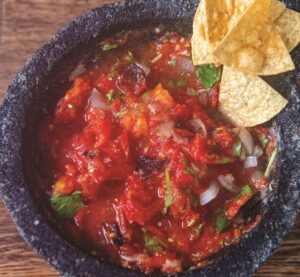Some grumble about the end of summer. Not me. Being able to turn onto Route 6 without taking my life into my hands is one thing I celebrate. September also brings other favorite things my way: there’s U.S. Open tennis, there are terrapins hatching at the Audubon, and there is so much to do with these last and best tomatoes of the year.
My counters are covered with bursting beefsteaks, candy-sweet cherries, sunny yellow plums, green zebras, saucy romas, and black beauties from local farmers markets. They’ve been tossed into salads and blitzed for gazpacho, but now is when Robert and I put up tomato sauce for the winter. We always follow my friend Kathy Gunst’s recipe, which calls for giving the tomatoes a high-temperature roasting that lends the sauce smoky, caramelized notes.

I am grateful to many tomato tutors and find myself going back to them as we deal with this abundance. There is Marcella Hazan’s definitive sauce with butter in Essentials of Classic Italian Cooking, published in 1992. And Lynne Rossetto Kasper’s treatise on how techniques affect flavor in The Italian Country Table is brilliant. If you see her 1999 cookbook, buy it. It will change your pasta and tomato game for good.
Going back deeper into the tomato’s roots means looking to the Mexican kitchen. In summer, there’s pico de gallo. The raw salsa that combines tomatoes with fresh chiles, onions, garlic, and cilantro is wonderfully addictive on a tortilla chip. I like to follow that with a September salsa that starts with blistering tomatoes over live fire on an unglazed earthenware flat round, called a comal. The fire adds a kiss of smoke, and while the skins blacken the tomatoes’ juices bubble.
I carried a clay comal home from Oaxaca on my lap on the plane last year, but after our curious cat, Opal, knocked it to the floor, I learned to love my metal version. The light, thin metal distributes heat evenly and reacts quickly to adjustments, fundamental when making tortillas or toasting chiles. Besides, according to Diana Kennedy, comales were commonly made from recycled oil drum tops. The comal is the opposite of the three-ply fancypants copper-clad cookware of ersatz French kitchens. An American griddle or cast-iron skillet can substitute, though they are not as heat-sensitive as straight-up steel.
Running the vegetables under the broiler for the char works well. It’s the method I turn to when it’s raining or when I’m making a big batch.
Whatever your method, permission to burn is a rare thing in cooking. But it develops the best the tomato has to offer: its juicy sweetness welcomes bitter notes from the char. For my version, whole garlics in their papery skins, a halved onion, and fresh or dried chiles get toasted alongside the tomatoes — I use big ones because you want the flesh the cherries lack. The roasting tempers the garlic and onion’s bite.
Note that this is done without any fat. Many cooks will tell you that fat equals flavor, but it’s just not needed here.

The chile-to-tomato ratio is your own party. A mild jalapeño will be warming, serrano steps up the heat by about three times, and habaneros are fruity but seriously fiery. The chiles’ seeds can be held back or added for intensity. If you can’t find fresh chiles, chipotles en adobo will add heat with a supporting smoky flavor.
In Mexico, the roasted chiles, aromatics, and tomatoes would be smashed in a molcajete, the volcanic stone mortar and pestle. A blender or food processor will do. I try to keep the texture chunky.
This salsa is a classic drizzled over tacos, grilled meats or fish, or scooped up with chips. But here we are in Wellfleet where spooning it over polenta with steamed littleneck clams is one fabulously comforting way to welcome fall.
Charred Tomato Salsa
Makes about 3 cups
1½ pounds ripe red tomatoes
2 to 4 garlic cloves in their skins
½ medium onion, unpeeled
2 to 4 fresh chiles, such as jalapeños, serranos, or habaneros
Kosher or coarse sea salt
Chopped cilantro (optional)
- Heat an outdoor grill, broiler, or griddle so it’s nice and hot.
- If working over a grill or the stovetop: Arrange the tomatoes, garlic, onion, and chiles on a comal, cast-iron skillet, or griddle. Cook, turning as needed, and remove each ingredient to a bowl once it chars: the garlic when soft with a little brown spot on its belly; the onion when softened and seared; the tomatoes when the skins blacken and split.
If using the broiler, position the oven rack closest to the heat element. Line a broiler pan with foil and arrange the tomatoes, garlic, onion, and chiles on it. Broil about 10-15 minutes, turning vegetables as needed and removing each as it chars. Wrap the tomatoes in the foil to catch the juices and let them cool.
- When cool enough to handle, slip the garlic and onions from their skins, but leave the blackened tomato skin. Mince the chiles (with the seeds if you like more heat). Chop the ingredients by hand and combine with all their juices for a chunky sauce. Alternatively, smoosh in a molcajete or large mortar and pestle, or pulse in a blender or food processor. Season generously with salt. Add cilantro if desired.



